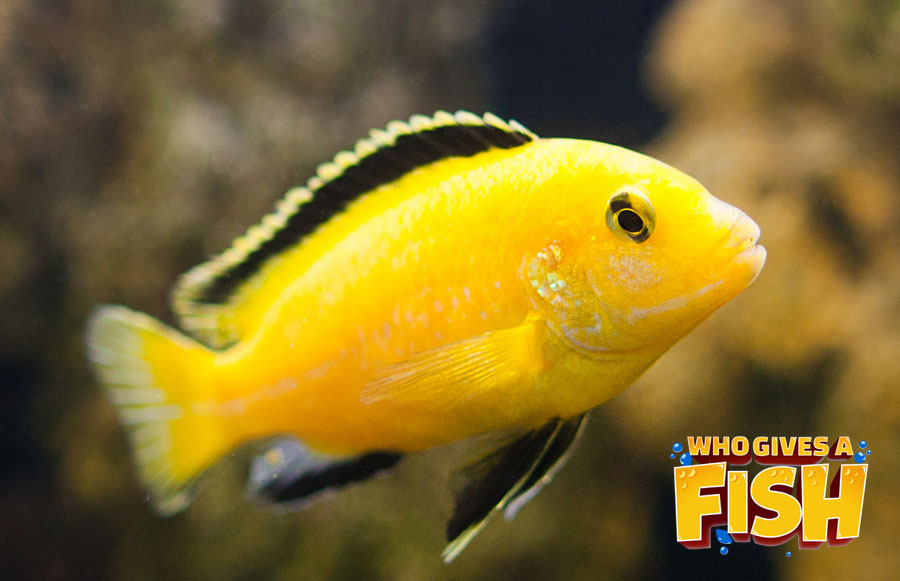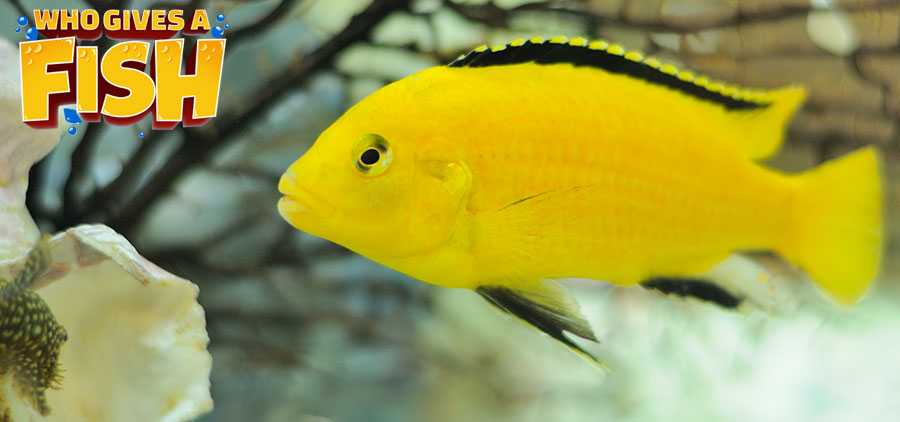Electric Yellow Cichlid
The Electric Yellow Cichlid, Labidochromis caeruleus, is often seen in most local fish stores and Cichlid keepers aquariums. Also known as the Yellow Lab or Electric Yellow Lab, this is a very hardy Cichlid with a great personality. Interbreeding has produced some stunning color variations, and breeding the Electric Yellow in captivity is very easy.
- Experience Level: Beginner
- Hardiness: Very hardy
- Minimum Tank Size: 30 gal (115 L)
- Maximum Size: 4 in. (10 cm)
- Temperament: Semi-aggressive, territorial.
- Temperature: 75 – 79° F (23.9 – 26.1° C)
- pH Range: 7.2 – 8.8
- Water Hardness:
- Diet: Omnivore
Table of Contents
Introduction
Aquarium Setup
Difficulty
Feeding
Breeding and Social
They are a common breeders beginner fish when learning to breed and sell due to the ease of producing young and selling them for a profit.
Classed as a Mbuna Cichlid, the Electric Yellow is a rock dweller and will spend it’s time swimming in and out of caves, and burrowing holes and pits in your gravel. They can become territorial and are known to chase down and attack smaller fish, however if fish of the same size and in a large aquarium are kept with the Electric Yellow, then aggression will be spread and should not be a problem.
Aquarium Setup
The Electric Yellow Cichlid demands high quality filtration and a higher pH than other Cichlids not from the African Lake Malawi. This lake has a high mineral content and as such, these Cichlids strive in a tank with increased pH. Adding crushed coral and oyster shell to a stocking bag and adding this to your canister filter or sump will help ensure the pH remains high enough. Aim for a pH of around 8 to 8.5 for optimal health and longevity.
Plants will often be dug up and moved to suit their own needs, and they are avid diggers and will rearrange your substrate whether you like it or not. Ensure you secure all rocks and equipment in your tank, as the Electric Yellow, especially when fully grown, will prove to be a nuisance when it comes to your hard aquascaping efforts.
Electric Yellow Cichlid Aquarium Guide
- Minimum Tank Size: 30 gal (115 L)
- pH Range: 7.2 – 8.8 (8 to 8.5 is optimal)
- Water Hardness: 10 – 20 dGH
- Temperature: 75 – 79° F (23.9 – 26.1° C)
- Lighting: Normal lighting
- Substrate: Sand / Gravel
- Brackish: No, however higher mineral content is required
- Water Flow: Weak to Medium
- Tank Region: All tank regions
Difficulty
This Cichlid is very easy to look after and is not a demanding species. The only considerations are the high quality filtration required along with the higher pH requirements (around 8 to 8.5 is best). They will become territorial in a smaller, less populated tank and can become aggressive when breeding, however, they are an otherwise peaceful, fun Cichlid to keep.
Feeding
The Electric Yellow Cichlid is not a fussy eater and will take most foods. As with many Cichlids, it is important not to feed them warm blooded animals meats or fats as this can cause digestive issues. Cichlid specific pellet and flake foods are a good addition to their diet, as are foods with added spirulina to assist in bright coloration. They will also eat partly cooked dark leafy greens.
Electric Yellow Cichlid Feeding Guide
- Diet: Omnivore
- Frequency: Several small feedings per day
- Pellet Foods: Yes, Cichlid specific pellet foods. A blend with spirulina is recommended
- Flake Foods: Yes, Cichlid specific flake foods. A blend with spirulina is recommended
- Live Foods: Sometimes. Offer worms and smaller fish as a treat
- Meat Foods: Only fish/crustaceans. No warm blooded animal meat or fat
- Vegetable Foods: They enjoy partly cooked dark leafy greens and soft cooked brocolli
Breeding
Males are generally larger and will develop a blue tinge to them when breeding. Mature fish can also be removed and examined for vent differences.
The Electric Yellows are mouth brooders and are fascinating to watch in captivity. Unless purchasing a breeding pair, you can usually get at least one pair form when purchasing several young fish together and letting them mature in the same tank.
The breeding process is very similar to the Kenyi Cichlid, in that the female will lay the eggs, and then suck them into her mouth. The male tricks her by waving his anal fin with the egg spot patterns and the female thinks these are eggs, attempting to also suck these up. The male will release his milt when she does this and in turn, fertilizes the eggs.
The mothers will often die if not carefully watched as they can be bullied and attacked by the male or other fish. As she will not eat for up to 4 weeks while the eggs hatch, she will become very weak and it is advised to remove her to a separate tank.
Once hatched the fry will begin to swim freely in and out of their mothers mouth and become more and more adventurous, depending on how quickly the mother is to suck them back in. They have a risk of being eaten, so once the mother has released the fry and they are free swimming, she can either be placed back into the main tank or a third tank to feed to back to good health before re-introduction to the main tank.
The fry will eat finely crushed Cichlid specific flake foods and brine shrimp. These are a great fish for beginners to breeding and often sell well in local markets for those adventurous hobbyists looking to also turn a profit.
Social
These Cichlids are quite peaceful and will do well with other peaceful fish. The only requirements are extra space when breeding and to ensure all fish have sufficient territory as the Electric Yellow can claim certain areas and chase away other fish. Overpopulating your tank (provided you have excellent filtration) will help iron out any aggression problems with this fish.



